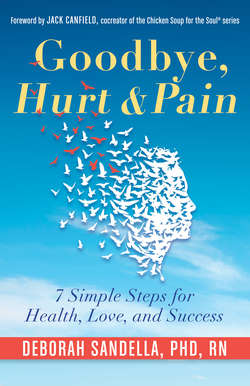Читать книгу Goodbye, Hurt & Pain - Deborah Sandella - Страница 18
На сайте Литреса книга снята с продажи.
HOW IT WORKS—PRACTICALLY AND SCIENTIFICALLY
ОглавлениеWe frequently speak of our feelings as if we are them. You hear it in our patterns of speech: “I am angry,” as if to say, “I am anger.” However, feelings naturally arise as passing states of awareness and are not part of us. Rather, they give feedback and then expire. Think of it as similar to how a thermometer measures our internal body temperature at 9:00 a.m. at a healthy 98.6 and, three hours later when we are getting the flu, it registers 101.5. The feedback that we have a fever allows us to make an informed decision about whether to take fever-reducing meds, call the doctor, or go to bed and wait it out. A feverish reading is temporary and will change. In the same way, our emotional temperature fluctuates depending on external and internal events and our reaction to them. Looking back at Kris's real-life story, we see how her bike accident and life-threatening allergic reaction created intense emotions that would have been temporary if she had not gotten stuck.
The origin of the word emotion is the 1570–80 Middle French word esmotion from movoir or motion; thus, esmovoir means “to set in motion or move the feelings.”1 The essential function of feelings is to provide feedback and pass through us organically like water flows in a river. In the same way water moves through the atmosphere, in and out of oceans, over and under land, human feelings continuously precipitate, go underground, rise to the surface, and evaporate through our awareness.
Trying to control our feelings through resistance and avoidance is like damming a river to stop the flow. An emotional dam pools feelings. This reservoir of avoided emotion remains in the body until we release it. In other words, the feelings we tried to avoid get held inside us instead. We hold on to what we are trying to avoid. Life constantly challenges us; it's not personal, just the natural process of growth and evolution. The stories of John and Kris demonstrate how easy it is to build emotional dams. Many times the process happens without us realizing it—until a symptom or illness gets our attention.
What emotional dams do you have in place? Distrust after a divorce? Shutting down emotionally after a job loss? Doubting yourself after a personal or professional rejection? Obsessing about safety after an accident? Let's explore the source of some emotional dams to gain more insight into how they operate in our lives.
